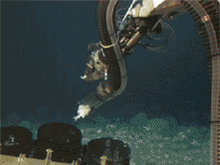Documenting Biodiversity Through Collecting
October 29, 2005
Dr. Martha Nizinski
Co-PI, NOAA, National Marine Fisheries Service National Systematics Laboratory
Although we have lost several days to weather, we have been extremely successful with our collections and observations. So far we have collected examples of several species of invertebrates (especially crustaceans and echinoderms) that we have not previously collected at our Lophelia study sites or have only seen once or twice before. With every collection we increase our overall knowledge of the site and the number of organisms we have observed associated with the Lophelia community.
Identification of the organisms we collect is the foundation of our investigation. Many animals cannot be identified correctly from a picture or a verbal description given by an observer. Often the distinguishing characters used to identify organisms require looking through a microscope or making counts and measurements. Thus, collections of animals are a top priority for our mission; correct identification cannot be accomplished without having the specimen in hand. Also, if we don't know what species are present, it is impossible to test hypotheses or make recommendations about conservation or management of these deep coral habitats.
Our accumulating data allow us to better determine what characters are important in identification and gain a better understanding of intraspecific variation and evolutionary relationships. Characters that are used to define a species are not absolute, but are reported as ranges with median values. Many individuals are needed, throughout the geographic range of the organism's distribution to determine the variability of each diagnostic character.
Sampling leads to a more complete picture of the faunal assemblage. Without specimens we would have a very different and less accurate view of the diversity in, on and around the Lophelia banks. For example, we have made several collections by suctioning a small area close to the reef in the rubble zone. Those samples were a gold mine of information. At least five species that we had not collected previously were represented in just one of those samples and all the animals were less than 10 mm in size. These individuals are too small to be seen from the sub or noticed on the video. These species would have been missed if we hadn't made those collections.
Each animal we collect becomes an integral part of several different aspects of our project. We extract as much data as possible from each specimen. For example, identifications will be incorporated into our invertebrate biodiversity database; measurements taken from the specimen will used to determine intraspecific variation; size and sex of the individual will be used for population dynamics work; descriptions of live colorations and data collected from video (habitat associations and behavioral observations) will provide additional natural history information; tissue samples will be utilized in our population and community genetics projects; and all specimens with their associated locality data will be used in interpretation of species distributions. These collections represent a snapshot in time, information that will never be available again.
The collections we make during our mission will benefit other scientists as well. Deep-sea research is very expensive, and few scientists have the opportunity to work in these environments. Many of these deep-sea species are poorly represented in museum collections. Also, many of these species were discovered centuries ago and perhaps have not been collected since. Museums function like libraries in that specimens are cataloged and archived and can be sent out on loan to researchers worldwide for examination. Thus, depositing recently collected material in research museums provides new information to experts studying various groups of organisms. Specimens collected on this mission will be available to the research community for many years to come.
By taking samples we gain a better understanding of the biodiversity and habitat associations of the organisms utilizing the Lophelia reefs. In the future we may be able to take fewer samples since we are building a reference collection to compare to the organisms that we see on the video. Animals do not exist in isolation. Each organism is a part of a larger assemblage and interconnected to other organisms through a variety of pathways. By looking at the larger picture we get a more complete view of this deep-sea ecosystem.
Sign up for the Ocean Explorer E-mail Update List.


























